ThHumipe soil covers our entire planet and corresponds to the most supedon: organic (H, O) and organo-mineral (A) horizons of a soil profile.
Orfganicial part of the earth's crust. Exposed to the attack of atmospheric agents and living organisms, the soil is organized in layers recognizable to the naked eye, more organic towards the atmosphere or water (if horizons (codes: H, O) are formed of dead organic matter (OM), mainly leaves, needles, twigs, roots and, under certain circumstances, other plant material such as mosses and lichens or remains of hydrophytes. This OM can remain not or little transformed when submerged), more mineral towards the rocky part of the bottom. To facilitate its study, specialists divided the soil into three sections: richer in (H: HF, HM, HS horizons) or be transformed in animal droppings following ingestion by soil/litter invertebrates and/or slowly decayed by microbial (bacterial and fungal) processes (OL, OF, OH horizons). A limit of 20% organisms part -> 1. Humipedon; bottom still in contc carbon (OC) by mass was established to define O horizons.
Organict with the unaltered rock section -> 3. Lithopedon; in-between, central, mineral part -> 2. Copedon. The present encyclopedia entry describes the variability-mineral horizons (code: A) are formed near the soil surface, generally beneath organic horizons. Coloured by organic matter, these horizons are generally darker than the underlying mineral layer of the humipedons of planet Earth. They have been subdivided in ecological groups and classified into different humus systemsoil profile. In the soil fraction Ø < 2 mm of the A horizon, organic carbon has to be less than 20% by mass. The aim is to display them and diffuse their knowledgere are terrestrial A horizons that are not or only periodically asphyxiated (maA, meA, miA, sgA, msA), or more or less submerged (anA, anaA).
- humus form
- humus
- soil
- litter
1. HumipedonUMIPEDON
1.1. Introduction
The founding fathers of pedology of the past century (Dukuchaev, Jenny, Hartmann, Stevenson, Leadley Brown, Duchaufour, all the original FAO group, and many others ...)[1][2][3][4][5][6][7][8] were lookuming for pedogenetic processes. In this, they were preceded by Darwin, the father of ecology and natural evolution concepts who first studied the formation of vegetable mould by earthwormn corres[9]. These foundamental classifications were "morpho-functional" (take note of those morphological aspects that facilitate the recognition of specific soil genesis and soil functioning). In 2003, 26 European forest soil specialists met in Trento (Italy) and founded the Humus group. They wanted to take stock on the classification of the European topsoils and realise a shared synthesis. In 2004 the group presented a first proposal of agreed reference at the Eurosoil Congress in Feibourg[10]. The group's nds to the part of the soil riclassification commission met every year and in 2018 the Humus group published 78 articles parted in three Applied Soil Ecology special Issues (N. 122a, 122b and 123); in these issues, the ost in organic and organo-mineral top section of the soil was called "Humipedon"[11][12].
The humipedon cormatteresponds to a living matrix that covers the whole planet. If you like Lovelock's concept of Gaia[13], you can see humipedon as a living film that encompasses like a skin the solid core of our planet. This membrane is not uniform. It is built by living beings in equilibrium with the rest of the biosphere. These living populations are dependent on the environment in which they develop, and adapt to it by changing both the environment and themselves over time, evolving with the planet as a whole. The ecologist's challenge is to discover how this matrix changes and goes over time, and how it interacts with the rest of the livings on the surface of the planet Earth. Because at the soil surface, what is alive or dying joins with what will come out from the ashes. It looks like a religious tale. The humipedon is only mysterious because little known, inhabited by invisible beings or strange small beasts, which can be scary only if magnified by the lens. Observed to the naked eye, a humipedon is composed of layers (called horizons by soil scientists) superimposed as in a sandwich with a total thickness varying from a few millimeters in the initial and young humipedons, up to an average of about ten centimeters in the more mature ones, with exceptions of even several meters in peat bog environments.
1.2. Definitions
Humus: Etymomofauna, miroorganisms, seeds and roots of plants (Figure 1). It is also the most active part of the soilogically it means "dirt, soil, earth". Homo or Human have a very similar meaning, "coming from dirt, earth, or made of dirt, earth". In practice, humus is characterized by the joint presence of two processes that occur in the superficial part of the soil: where the processes of mineralization (return to the meneral components) anand humification (construction of new of organic molecules). The set of molecules and organic and organo-mineral aggregates that undergo this combined transformation process is called humus. In each environment the two processes which are mainly biological occur in a characteristic way and give different humipedons.
Humipedon: orgatter take place and anic (codes: H, O) and organo-mineral (code: A) horizons of a soil.
Organic horizons (codes: H, O) are formed of dead organic maso tther (OM), mainly leaves, needles, twigs, roots and, under certain circumstances, other plant material such as mosses and lichens or remains of hydrophytes. This OM can remain not or little transformed when submerged (H: HF, HM, HS horizons) or be transformed in animal droppings following ingestion by soil/litter invertebrates and/or slowly decayed by microbial (bacterial and fungal) processes (O: OL, OF, OH horizons). A limit of 20% organic carbon (OC) by mass was established to define O horizons.
Organo-mineral horizons (code: A) are formed near the soil surface, making of the organo-mineral aggregenerally beneath organic horizons. Coloured by organic matter, these horizons are generally darker than the underlying mineral layer ote of the soil profile. In the soil fraction Ø < 2 mm of the
A horizon, organic carbon has to be less than 20% by mass. There are terrestrial A horizons that are not or only periodically asphyxiated (maA, meA, miA, sgA, msA), or more or less submerged (anaA, anA).
Humus system: categoroil profile may that contains morpho-functional equivalent humipedons. Visible to the naked eye or with a magnifying glass (x 10), some morphological characters allow in the field to assign the humipedons to a given humus system. Each humus system is generated by a functional group of living organisme parted in three sections that co-evolve in an ecologically circumscribed environment[141]. Within each humus system, the thickness of particular diagnostic horizon allows to assign each humipedon to more specific humus forms. Each humus system enumerates 2-4 humus forms. :
By1) making a hole in the ground of a forest, you discover a "face" of the soil, called a profile, on which three sections subdivided in horizons can be seen: a) Huhumipedon (horizons: H, O, A) [2] = organic and organo-mineral soil horizons; b
2) Ccopedon (horizons: E, B)[2] = mineral soil horizons; c
3) Llithopedon (horizon: C, and R layer) = rocky part of the soil, altered rock, top part of the solid Earth crust. The humipedon corresponds to the part of the soil richest in organic matter, pedofauna, miroorganisms, seeds and roots of plants (Figure 1). It is also the most active part of the soil, where the processes of mineralization and humification of organic matter take place as well as the making of the organo-mineral aggregate of the soil.
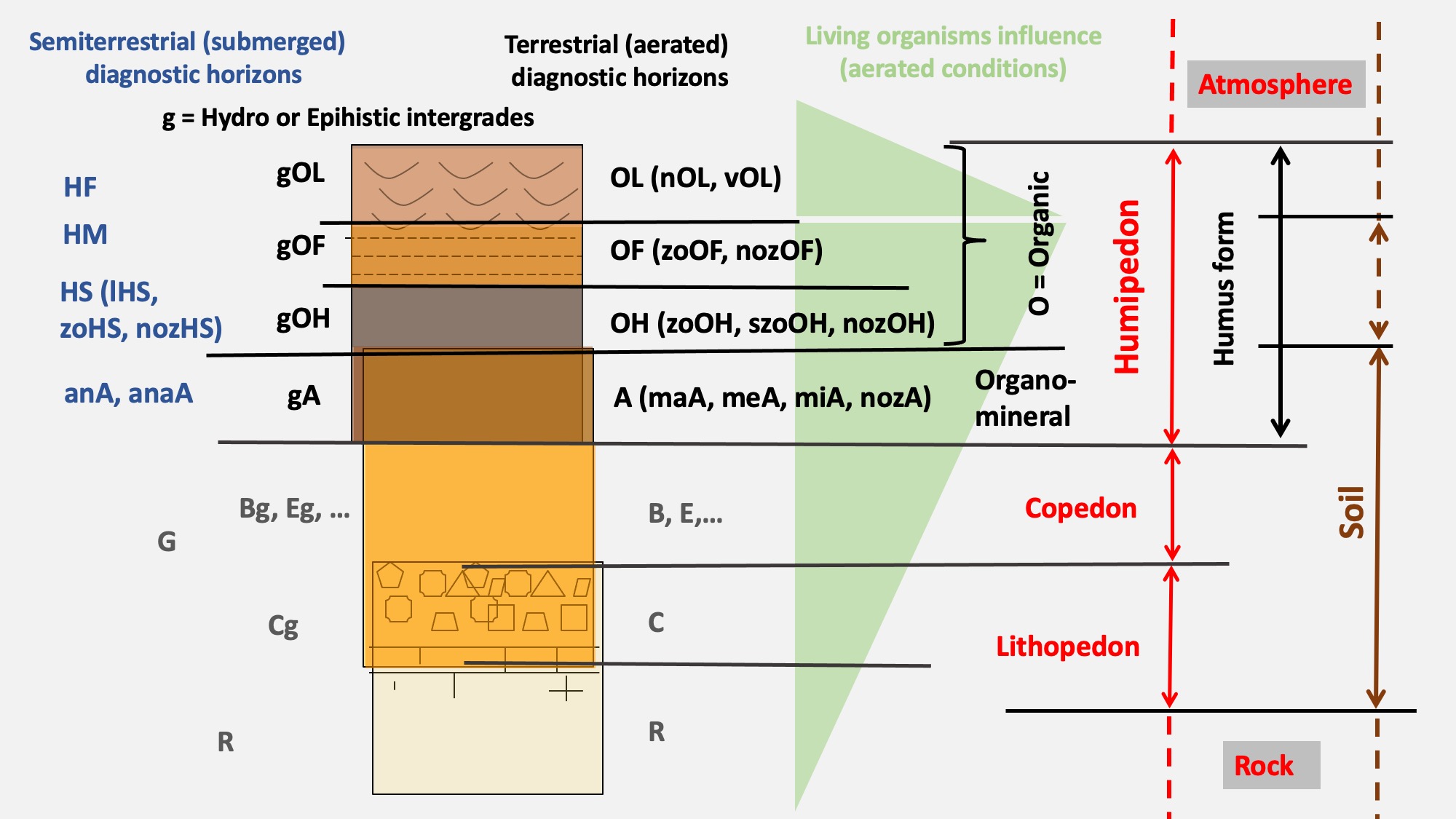
Figure 1. The distinction of Humipedon, Copedon and Lithopedon, with the list of diagnostic horizons in Terrestrial and Semi-terrestrial conditions.
The Humipedons covers the entire surface of the planet Earth and it changes in space and time. It is therefore more appropriate to speak of a mosaic of different humipedons of which this cover is composed. . They are essentially the physical spaces where, at the same time, both the decomposition of dead organic matter and the reconstruction of new organic matter take place. Depending on the environment of genesis and development, humipedons are different, as they are created by different organisms in equilibrium with the environment and with each other. In summary, we can say that these processes depend on the possibility of "oxidizing" (and/or "reducing") the organic matter in the air or in water. T and of making the components thus obtained interact chemically and physically andto create new organic, organo-mineral or mineral structures, in more or less aerated eenvironments. Tless rich in water. If the pores of the matrixsubstrate in which these processes take place may be filled by air or water in a dynamic exchange. The length of stay in the pores of water or air are full of water, there is no air, and vice versa. This aspect divides the humipedons into two broad categories: Terrestrial (long residence times of air = presence of oxygenrather in the air) and Semiterrestrial (long residence times of water = lack of oxygenmore or less in water). However, there are also particular conditions of birth and development of these humipedons. The "youngs"" ones differ from the more developed ones. When young, they are highly dependent on external and dominant groups of organisms that build them and assign a recognizable appearance to humipedon. As they evolve, they converge into typical systems that we could define as "central references""adults", that is, characterized by a certain independence from the environment in which they develop. There are also humipedons characteristic of areas that are very difficult for living beings to inhabit, with high pressures and temperatures or strong acidity. For this reason, central humus systems and satellite humus systems can be seen in Figure 2. The central systems were namedfirst are the Terrestrial (red on Figure 2), Histic (blue) orand Aqueous (green); the satellite ones, Para (grey). In the central part there are also two Anthropogenic humus light green) systems, named Agro and Techno (black).
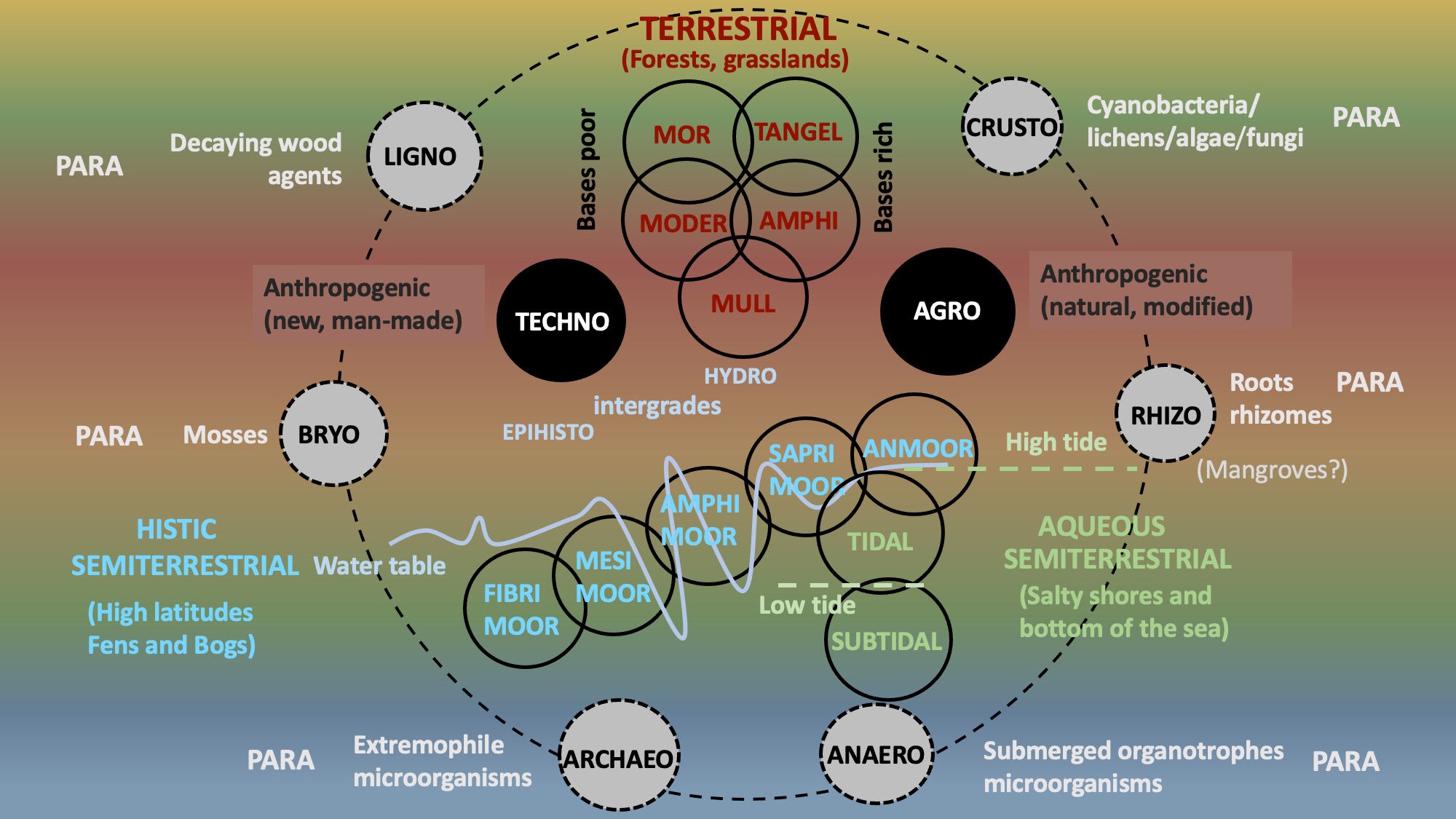
Figure 2. The humus sys; tem that cover planet Earth. Terrestrial (forests and grasslands): Mull, Moder, Mor, Amphi, Tangel; Histic (Fens and Bogs): Anmoor, Saprimoor, Anphimoor, Mesimoor, Fibrimoor; Aqueous (salty shores and bottom of the sea); Anthropogenic Agro (natural humipedons modified for agricultural purposes) and Techno (man made composts, dumps, hydroponic solutions,...). Para humipedons are represented as satellites of the "e second are the gray Para ones. In the central" humipedons because they can either remain independent, or evolve towards the more developed ones, depending on the dynamics of the water and other ecological factors.
2. Main Ecological and Morpho Functional Groups of Humipedons
For ea part there are also two anthropogenic syse of recognition and interpretation, humipedons can be assigned to four major ecological and morpho-functional categories:ems of black color.
1

Figure 2. The humus system that cover planet Earth. Terrestrial (forests and grasslands): Mull, Moder, Mor, Amphi, Tangel; Histic (Fens and Bogs): Anmoor, Saprimoor, Anphimoor, Mesimoor, Fibrimoor; Aqueous (salty shores and bottom of the sea); Anthropogenic Agro (natural humipedons modified for agricultural purposes) and Techno (man made composts, dumps, hydroponic solutions,...). Para humipedons are represented as satellites of the other humipedons because they can either remain independent, or evolve towards the more developed ones in the central area.
Main groups of humipedons
- Terrestrial humus systems[153]: not or submerged for a few days a year; 2
- Semiterrestrial humus systems: 2a
- Histic humus systems[164]: submerged but not subjected to strong daily tides; 2b
- Aqueous humus systems[175]: by the sea, in salt water and affected by tides with a daily rhythm. 3
- Para humus systems[186]: These are humipedons either of initial soils or of soils linked to specific "out of standard" environmental conditions. They are represented in gray circles on figure 2; 4 .
- Anthropogenic humus systems: Agro humus systems[197] or Techno[8] humus systems. The Agro's are Terrestrial, Semiterrestrial or Para humimipedons modified by man to be cultivated, and contain diagnostic horizons similar to the original natural ones. The Techno's instead are: 1) manure humipedons (different types of composts), 2) soil-free humipedons (from hydroponic solution to porous clay artificial agregatesg), 3) dump humipedons (various types of landfills).
2.1. Terrestrial (Figure 3)
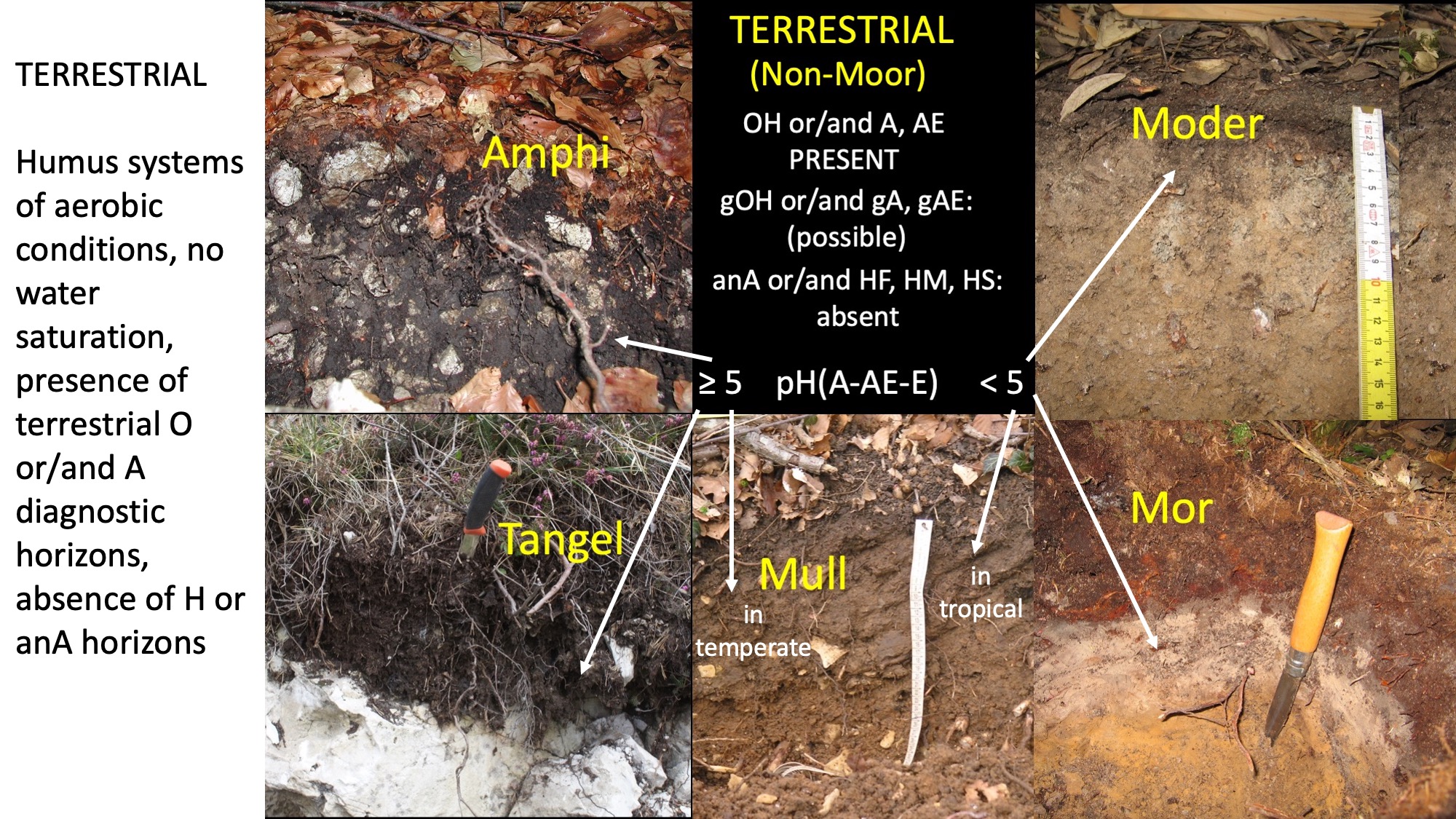
Figure 3. former are Terrestrial, humus systems. We see that they are not in water and relatively dry. We are in forests, shrubs, grasslands, where you can walk without sinking. It is also seen that they have evolved, because they got a consistent thicknesses of about 5-50 cm. For this aspect concerning the evolution and thickness it is necessary to compare with Para systems. On this figure there are only forest and well developed huSemiterrestrial or Para humipedons. The Mull is made by animals that mix efficaciously organic matter and soil; no organic remains are seen with the naked eye when looking at the humipedon; the leaves become soil, organo-mineral lumps of soil, with the still uneaten litter that lays at the top, eventually. These animals eat all the litter that falls in the year, letting the soil nude before a new fall. The animals that originate this structure are earthworms or large insects larvae. In this case, what we call soil is 100% made of their excrement. The Mull is formed in temperate environments to which these animals are well adap modified by man to be cultivated. The Mull is found is all temperate plains of the world. The environment changes as you go up in altitude, or go towards the Earth's poles. The actors of biodegradation and the formation of humipedons change. If the substrate is acidic, the humus system passes from Mull to Moder and then to Mor; if, on the other hand, it is carbonatic, it goes first to the Amphi and then to the Tangel. This is a general rule. In reality, it is also possible to meet Mulls in mountains sites and Mor in the plains, when the environment becomes locally temperate or protected in the first case, or decidedly acidic or difficult in the second. For a complete reading of the humipedon coverage it is also necessary to know the Para systems, which can be superimposed or juxtaposed with the more advanced ones. In the mountains, for example, the prairie is characterized by a Rhizo system under which a Mull system can develop. The dominant system is a Mull in the valley floor and in the lower part of the slope, the Rhizo becomes dominant when the humipedon is 10 cm or less thick, high on the clinal and near the outcropping rocks. To see illustrated examples of Terrestrial humus systems, please refer to:
2.2. Semiterrestrial
The Semitery contain diagnostic horizons similar to the orestrial systems contain humipedons more or less related to environments rich in water. At first the peaty's were distinguished from the more mineral ones, then those with a more or less prolonged duration of the submersion cycle from those that had an hourly cycle linked to the tides. The latter are also generally saltier than the formerginal natural ones.
a. Histic (Figure 4)
Fens and Moors.
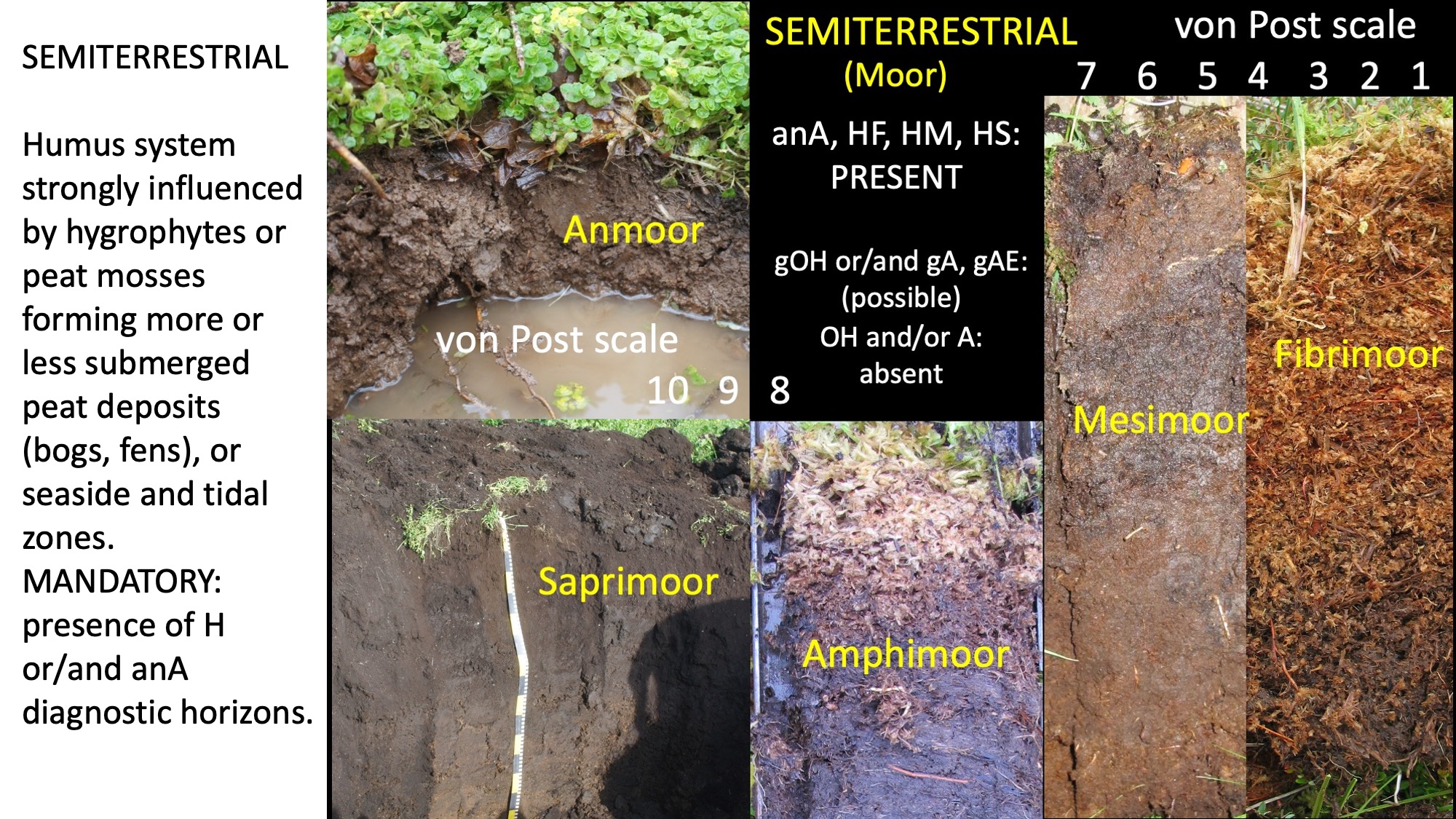 Figure 4. Semiterrestrial Humus Systems. In these environments there are hygrophilous plants and the rather organic matrix is generally dark. The figure shows the von Post scale which indicates the degree of decomposition of the vegetation in the humipedon horizons; this scale is low when the plant components are almost intact and visible, it becomes 10 when they have become dark soil. An easy way to distinguish the three main organic horizons is to squeeze a fistful of material: if clean water comes out, HF (little or not decomposed plant material von Post from 1 to 3); dirty water comes out, HM (von Post from 4 to 7); no water comes out but paste-soil if wet, HS (von post from 8 to 10). "Ana" (typical in Anmoor) is an organo-mineral diagnostic horizon, a paste similar to HS but with an organic carbon content ≤ 20%. Passing from left to right on the figure, we go towards increasingly submerged environments. To know more about these humichno instead are: 1) maniure humipedons, refer to :[20]
Figure 4. Semiterrestrial Humus Systems. In these environments there are hygrophilous plants and the rather organic matrix is generally dark. The figure shows the von Post scale which indicates the degree of decomposition of the vegetation in the humipedon horizons; this scale is low when the plant components are almost intact and visible, it becomes 10 when they have become dark soil. An easy way to distinguish the three main organic horizons is to squeeze a fistful of material: if clean water comes out, HF (little or not decomposed plant material von Post from 1 to 3); dirty water comes out, HM (von Post from 4 to 7); no water comes out but paste-soil if wet, HS (von post from 8 to 10). "Ana" (typical in Anmoor) is an organo-mineral diagnostic horizon, a paste similar to HS but with an organic carbon content ≤ 20%. Passing from left to right on the figure, we go towards increasingly submerged environments. To know more about these humichno instead are: 1) maniure humipedons, refer to :[20]
b. Aqueous
Tidalic seasides.
T (the Aqueous are still and strangely little studied. They would be very interesting because they correspond to the shallow edges of rivers, lakes, seas, oceans and tidal zones. They are the result of interaction with the remains and activities of aquatic microorganisms, animals and plants. They are different from Histic because they are more mineral, generally salty and with a clearer distinction between humipedons asphyxiated or periodically ventilated over the course of a day. They are certainly interesting for those who keep fish or crustaceans or aquatic animals in general. Basics of classification here:
2.3. Para Humus Systems
The study of Para systeifferent types of coms is not accidental. It is impossible to understand other humus systems without first observing what happens when they are young or different from the standard ones. The normal growth series of humus systems is this: a) few and quite invisible microorganisms on any substrate (they are called microbial films; not considered in our classification); b) growing, these micro-ts), 2) soil-free humipedons become larger Anaero or Archaeo or Crusto in our classification, depending on the environment in which they generate; later, they may evolve into c) Bryo, then d) Rhizo, ending in e) Terrestrestrial, or Semiterrestrial, or Aqueous systems or f) Anthropogenic. If you look at them on Figure 5, you will find that you have already seen them somewhere. Other examples, here:[18]
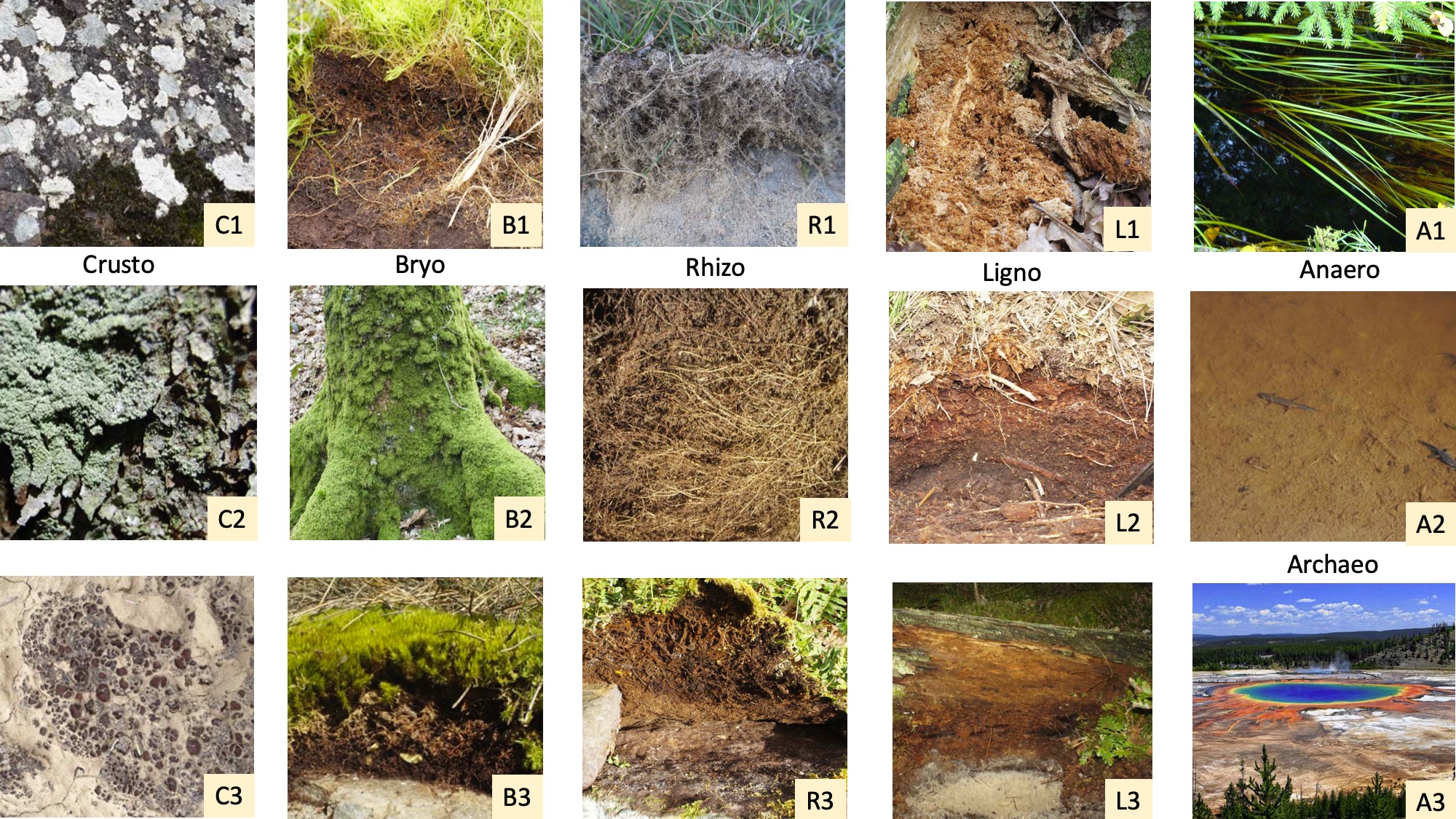
Figure 5. Para h(from hydroponic solumus systems, in column from left to right, examples of Crusto, Bryo, Rhizo, Ligno, Anaero (A1,A2), and Archeo (A3).
2.4. Anthropogenic Humus Systems
Hion to poroumans use humipedons to live (Figure 6). To produce the food we need, we change the vegetation cover by planting species of our own taste. In general, this turns all pre-existing natural humipedons into Agro Mull (or Agro Anmoor in wet environments). A Rhizo Mull (Rhizo laying on a Mull system) is found in all natural or artificially grazed graminaceous environments . Humipedons can also be completely artificial (Techno humus systems), as may be landfills, waste, concrete, compost heaps, even hydroponic solutions.
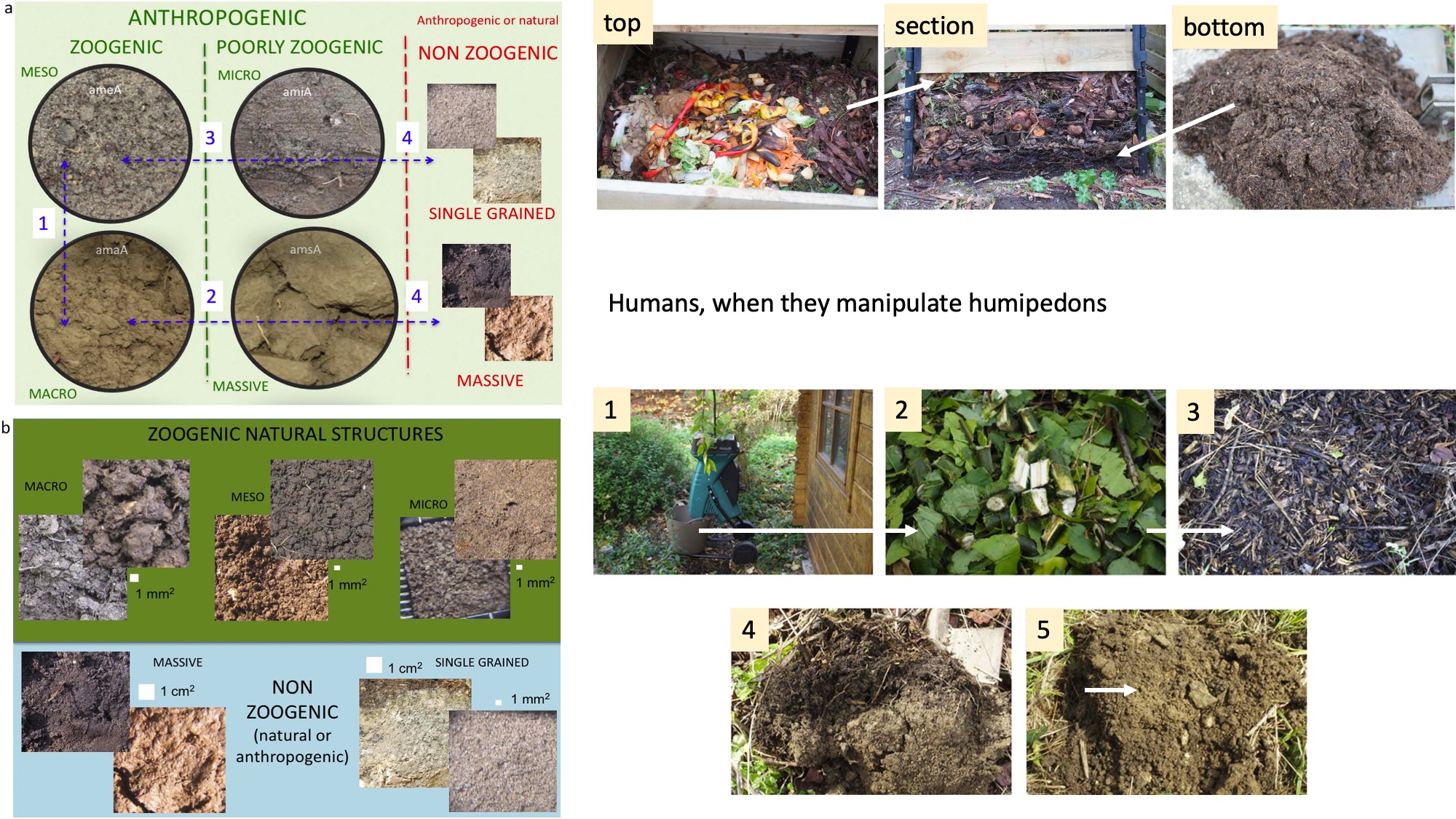
Figure 6. Agro Anthropogenic humus systems. aclay balls) and b): comparing natural and anthropogenic soil structures. Right part, homemade compost production (above), or direct and surface distribution of ground leaf and wood, to nourish the soil. To know more, please refer to:[17][19][21]
3. Perspectives
We have s3) dump hown the broad lines of a much more complex general picture. All the bottoms and seabeds of the world are missing (oceans, seas, lakes and rivers). We know that to classify the Histic humimipedons considering only the top 40 cm may be a nonsense; they can reach depths of meters. The frozen humipedons have not been classified and occupy areas that are thawing as a result of global warming.
We are far from having understood the functional difference between the humus systems. A Mull generated by earthworms is different from a Mull built by insects' larvae or crustaceans, even if the result (absence of OH horizon, litter disappearing in one year) looks very similar. There are groups of soil animals that can be associated with humus systems, but we are far from true lists of species. We know almost nothing about the microorganisms that can be associated with the different humus systems. DNA analyzes that have become much more affordable could help in this type of research.
Thearious types Para systems are a completely unexplored mine and of undoubted biological, ecological and economic interests. Message to young scientists: life came from the soil (probably a very liquid soil[22]f landfills); understanding the soil is understanding the origin of life, a process still active even today.
References
- Dokoutchaief B.. Tchernozème (terre noire) de la Russie d'Europe; Soc. imp. libre économ. C.R. Soc. imp. libre économ. T. 4: St.-Ptb., 1879; pp. 1-66.Augusto Zanella; Jean-François Ponge; Jean-Michel Gobat; Jérôme Juilleret; Manuel Blouin; Michaël Aubert; Oleg Chertov; José Luis Rubio; Humusica 1, article 1: Essential bases – Vocabulary. Applied Soil Ecology 2018, 122, 10-21, 10.1016/j.apsoil.2017.07.004.
- Henry E.. Les sols forestiers.; Berger-Levrault Ed.: Paris-Nancy, 1908; pp. 485.Augusto Zanella; Cristian Bolzonella; Jeff Lowenfels; Jean-François Ponge; Marcel Bouché; Debasish Saha; Surinder Singh Kukal; Ines Fritz; Allan Savory; Manuel Blouin; et al.Luigi SartoriDylan TattiLiv Anna KellermannPeter TrachselStéphane BurgosBudiman MinasnyMasanobu Fukuoka Humusica 2, article 19: Techno humus systems and global change–conservation agriculture and 4/1000 proposal. Applied Soil Ecology 2018, 122, 271-296, 10.1016/j.apsoil.2017.10.036.
- Jenny, Hans. The Soil Resource, Origin and Behaviour; Springer-Verlag: New York, 1980; pp. 284.Augusto Zanella; Jean-François Ponge; Bernard Jabiol; Giacomo Sartori; Eckart Kolb; Jean-Michel Gobat; Renée-Claire Le Bayon; Michaël Aubert; Rein De Waal; Bas Van Delft; et al.Andrea VaccaGianluca SerraSilvia ChersichAnna AndreettaNathalie CoolsMichael EnglischHerbert HagerKlaus KatzensteinerAlain BrêthesCristina De NicolaAnna TestiNicolas BernierUlfert GraefeJérôme JuilleretDamien BanasAdriano GarlatoSilvia ObberPaola GalvanRoberto ZampedriLorenzo FrizzeraMauro TomasiRoberto MenardiFausto FontanellaCarmen FilosoRaffaella DibonaCristian BolzonellaDiego PizzeghelloPaolo CarlettiRoger LangohrDina CattaneoSerenella NardiGianni NicoliniFranco Viola Humusica 1, article 4: Terrestrial humus systems and forms — Specific terms and diagnostic horizons. Applied Soil Ecology 2018, 122, 56-74, 10.1016/j.apsoil.2017.07.005.
- Kubiena, W.L.. Bestimmungsbuch und Systematik der Böden Europas.; F. Enke Verlag: Stuttgart, 1953; pp. 392.Augusto Zanella; Rein De Waal; Bas Van Delft; Jean-François Ponge; Bernard Jabiol; Maria De Nobili; Chiara Ferronato; Jean-Michel Gobat; Andrea Vacca; Humusica 2, Article 9: Histic humus systems and forms—Specific terms, diagnostic horizons and overview. Applied Soil Ecology 2018, 122, 148-153, 10.1016/j.apsoil.2017.05.026.
- Hartmann, Franz. Der Waldboden Humus-, Boden- und Wurzeltypen als Standortsanzeiger; Österreichisches Produktivitäts-zentrum, Eds.; Ueberreuter: Wien , 1951; pp. 151.Augusto Zanella; Chiara Ferronato; Maria De Nobili; Gilmo Vianello; Livia Vittori Antisari; Jean-François Ponge; Rein De Waal; Bas Van Delft; Andrea Vacca; Humusica 2, article 12: Aqueous humipedons – Tidal and subtidal humus systems and forms. Applied Soil Ecology 2018, 122, 170-180, 10.1016/j.apsoil.2017.05.022.
- Stevenson, F.J.. Humus Chemistry: Genesis, Composition, Reactions, 2nd Edition; Dept. Agronomy University Illinois, Eds.; John Wiley & Sons, inc: New York, 1994; pp. 1-248.Augusto Zanella; Jean-François Ponge; Ines Fritz; Nicole Pietrasiak; Magalì Matteodo; Marina Nadporozhskaya; Jérôme Juilleret; Dylan Tatti; Claire Le Bayon; Lynn Rothschild; et al.Rocco Mancinelli Humusica 2, article 13: Para humus systems and forms. Applied Soil Ecology 2018, 122, 181-199, 10.1016/j.apsoil.2017.09.043.
- Leadley Brown, Alison. Ecology of Soil Organisms; Heinemann Educational Books: London, 1978; pp. 116.Augusto Zanella; Jean-François Ponge; Stéphanie Topoliantz; Nicolas Bernier; Jérôme Juilleret; Humusica 2, Article 15: Agro humus systems and forms. Applied Soil Ecology 2018, 122, 204-219, 10.1016/j.apsoil.2017.10.011.
- Duchaufour, Ph; Souchier, B.. Pedologie 1. Pédogenèse et classification; Masson, Eds.; Masson: Paris, 1977; pp. 1-477.Augusto Zanella; Jean-François Ponge; Stefano Guercini; Clelia Rumor; François Nold; Paolo Sambo; Valentina Gobbi; Claudia Schimmer; Catherine Chaabane; Marie-Laure Mouchard; et al.Elena GarciaPiet van Deventer Humusica 2, article 16: Techno humus systems and recycling of waste. Applied Soil Ecology 2018, 122, 220-236, 10.1016/j.apsoil.2017.09.037.
- Darwin, C.. The formation of vegetable mould through the action of worms, with observations on their habits; John Murray, Albemarle Street: London, 1881; pp. 76.Augusto Zanella; Jean-François Ponge; Stefano Guercini; Clelia Rumor; François Nold; Paolo Sambo; Valentina Gobbi; Claudia Schimmer; Catherine Chaabane; Marie-Laure Mouchard; et al.Elena GarciaPiet van Deventer Humusica 2, article 16: Techno humus systems and recycling of waste. Applied Soil Ecology 2018, 122, 220-236, 10.1016/j.apsoil.2017.09.037.
- Jabiol, B.; Zanella, A.; Englisch, M.; Hager, H.; Katzensteiner, K.; De Waals, R.. Paper « Eurosoil ». Towards a European Classification of Terrestrial Humus Forms. ; Albert Ludwigs Universität: Freibourg (Germany), 2004; pp. 10.
- Augusto Zanella; Jean-François Ponge; Jean-Michel Gobat; Jérôme Juilleret; Manuel Blouin; Michaël Aubert; Oleg Chertov; José Luis Rubio; Humusica 1, article 1: Essential bases – Vocabulary. Applied Soil Ecology 2018, 122, 10-21, 10.1016/j.apsoil.2017.07.004.
- Augusto Zanella; Cristian Bolzonella; Jeff Lowenfels; Jean-François Ponge; Marcel Bouché; Debasish Saha; Surinder Singh Kukal; Ines Fritz; Allan Savory; Manuel Blouin; et al.Luigi SartoriDylan TattiLiv Anna KellermannPeter TrachselStéphane BurgosBudiman MinasnyMasanobu Fukuoka Humusica 2, article 19: Techno humus systems and global change–conservation agriculture and 4/1000 proposal. Applied Soil Ecology 2018, 122, 271-296, 10.1016/j.apsoil.2017.10.036.
- James E. Lovelock; Hands up for the Gaia hypothesis. Nature 1990, 344, 100-102, 10.1038/344100a0.
- Augusto Zanella; Jean-François Ponge; Bernard Jabiol; Giacomo Sartori; Ekart Kolb; Renée-Claire Le Bayon; Jean-Michel Gobat; Michaël Aubert; Rein De Waal; Bas Van Delft; et al.Andrea VaccaGianluca SerraSilvia ChersichAnna AndreettaRaimo KõlliJean Jacques BrunNathalie CoolsMichael EnglischHerbert HagerKlaus KatzensteinerAlain BrêthesCristina De NicolaAnna TestiNicolas BernierUlfert GraefeUgo WolfJérôme JuilleretAndrea GarlatoSilvia ObberPaola GalvanRoberto ZampedriLorenzo FrizzeraMauro TomasiDamien BanasFabrice BureauDylan TattiSandrine SalmonRoberto MenardiFausto FontanellaVinicio CarraroDiego PizzeghelloGiuseppe ConcheriAndrea SquartiniDina CattaneoLinda ScattolinSerenella NardiGianni NicoliniFranco Viola Humusica 1, article 5: Terrestrial humus systems and forms — Keys of classification of humus systems and forms. Applied Soil Ecology 2018, 122, 75-86, 10.1016/j.apsoil.2017.06.012.
- Augusto Zanella; Jean-François Ponge; Bernard Jabiol; Giacomo Sartori; Eckart Kolb; Jean-Michel Gobat; Renée-Claire Le Bayon; Michaël Aubert; Rein De Waal; Bas Van Delft; et al.Andrea VaccaGianluca SerraSilvia ChersichAnna AndreettaNathalie CoolsMichael EnglischHerbert HagerKlaus KatzensteinerAlain BrêthesCristina De NicolaAnna TestiNicolas BernierUlfert GraefeJérôme JuilleretDamien BanasAdriano GarlatoSilvia ObberPaola GalvanRoberto ZampedriLorenzo FrizzeraMauro TomasiRoberto MenardiFausto FontanellaCarmen FilosoRaffaella DibonaCristian BolzonellaDiego PizzeghelloPaolo CarlettiRoger LangohrDina CattaneoSerenella NardiGianni NicoliniFranco Viola Humusica 1, article 4: Terrestrial humus systems and forms — Specific terms and diagnostic horizons. Applied Soil Ecology 2018, 122, 56-74, 10.1016/j.apsoil.2017.07.005.
- Augusto Zanella; Rein De Waal; Bas Van Delft; Jean-François Ponge; Bernard Jabiol; Maria De Nobili; Chiara Ferronato; Jean-Michel Gobat; Andrea Vacca; Humusica 2, Article 9: Histic humus systems and forms—Specific terms, diagnostic horizons and overview. Applied Soil Ecology 2018, 122, 148-153, 10.1016/j.apsoil.2017.05.026.
- Augusto Zanella; Chiara Ferronato; Maria De Nobili; Gilmo Vianello; Livia Vittori Antisari; Jean-François Ponge; Rein De Waal; Bas Van Delft; Andrea Vacca; Humusica 2, article 12: Aqueous humipedons – Tidal and subtidal humus systems and forms. Applied Soil Ecology 2018, 122, 170-180, 10.1016/j.apsoil.2017.05.022.
- Augusto Zanella; Jean-François Ponge; Ines Fritz; Nicole Pietrasiak; Magalì Matteodo; Marina Nadporozhskaya; Jérôme Juilleret; Dylan Tatti; Claire Le Bayon; Lynn Rothschild; et al.Rocco Mancinelli Humusica 2, article 13: Para humus systems and forms. Applied Soil Ecology 2018, 122, 181-199, 10.1016/j.apsoil.2017.09.043.
- Augusto Zanella; Jean-François Ponge; Stéphanie Topoliantz; Nicolas Bernier; Jérôme Juilleret; Humusica 2, Article 15: Agro humus systems and forms. Applied Soil Ecology 2018, 122, 204-219, 10.1016/j.apsoil.2017.10.011.
- Augusto Zanella; Rein De Waal; Bas Van Delft; Jean-François Ponge; Chiara Ferronato; Maria De Nobili; Renée-Claire Le Bayon; Anna Andreetta; Raimo Kõlli; Humusica 2, article 10: Histic humus systems and forms – Key of classification. Applied Soil Ecology 2018, 122, 154-161, 10.1016/j.apsoil.2017.06.035.
- Augusto Zanella; Stefan Geisen; Jean-François Ponge; Gerard Jagers; Charles Benbrook; Thomas Dilli; Andrea Vacca; Jolanta Kwiatkowska-Malina; Michaël Aubert; Silvia Fusaro; et al.Maria De NobiliGiovanna LomolinoTiziano Gomiero Humusica 2, article 17: techno humus systems and global change − three crucial questions. Applied Soil Ecology 2018, 122, 237-253, 10.1016/j.apsoil.2017.10.010.
- Miller, S.; Urey, H.; Organic Compound Synthes on the Primitive Eart. Science 1959, 130, 245-251.
